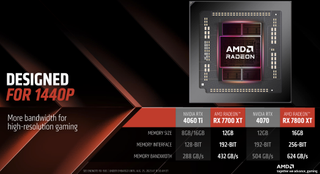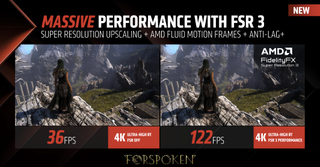Everything you need to know about AMD's FSR 3 upscaling and Fluid Motion Frames technology
Taking the fight to Nvidia's DLSS 3 with Frame Generation at last.

So, AMD has finally fleshed out more details of its next-gen Fidelity FX Super Resolution 3 (FSR 3) upscaling technology complete with Fluid Motions Frames. The latter is a direct response to Nvidia's innovative Frame Generation tech in DLSS 3. First announced last November, AMD has been bigging up Fluid Motion Frames to boost the appeal of its new Radeon RX 700 XT and 7800 XT GPUs, but hasn't provided a precise launch date.
And, sadly, still hasn't. But at least we now have some more concrete details about how it works, what it will run on, and what sort of performance uplift we might be able to expect when it does finally launch.
So how, exactly, does Fluid Motion Frames work, how does it compare to Nvidia's Frame Generation, how does it fit in with the broader FSR 3 package, what games and GPUs support it, and what, ultimately, should you make of it all?
What is AMD's Fluid Motion Frames?
The basic idea is easy enough: FSR 3 with Fluid Motion Frames is AMD's answer to Nvidia's Frame Generation technology and DLSS 3. Just like Nvidia Frame Gen, AMD Fluid Motion Frames (FMF) interpolates new frames based on existing frame data and inserts them in between frames rendered using the full 3D pipeline.
So in both cases, the result is improved visual fluidity or smoothness, but not any real additional performance. Indeed, there's actually a cost in terms of response or latency of running these frame generation technologies. That's why Nvidia's Frame Generation must run alongside its latency-reducing Reflex tech and likewise AMD has a revised Anti-Lag+ feature to help reduce latency with FMF.
How does AMD's Fluid Motion Frames technology work?
Unlike Nvidia's Frame Generation, which requires dedicated hardware acceleration from the Ada GPUs, AMD FMF is essentially a software solution. Both platforms use a combination of motion vectors and optical flow analysis. The difference is that Nvidia's RTX GPUs have dedicated optical flow accelerating blocks, while AMD does all the calculations in the GPUs shaders using asynchronous compute capacity.
The immediate upshot is that the performance of AMD FMF is at least partially contingent on how much of the GPU's asynchronous compute is being used by the game itself. That can vary, and thus FMF performance will vary from game to game.
That's probably why AMD recommends a base performance of 60 fps before enabling FMF. However, that 60 fps baseline performance can, of course, include the frame rate increase from enabling FSR upscaling.
The software rather than hardware basis of FMF also has one obvious benefit. It's much more widely compatible than Nvidia Frame Generation. Nvidia says its Frame Generation must be restricted to its very latest RTX 40-series hardware because only those GPUs have sufficient optical flow performance. AMD's software approach means that no such limitations apply to FMF.

What's the difference between FSR 3 and Fluid Motion Frames?
Just as with Nvidia's DLSS 3 and Frame Generation, the question of to what extent FSR 3 and Fluid Motion Frames are distinct can be confusing. FSR 3 is a superset containing AMD's latest FSR upscaling with Fluid Motion Frames and anti-lag technology.
What isn't entirely clear is whether FSR 3 has a new implementation of AMD's upscaling technology. However, AMD does say that FSR 3 can be run without FMF and in that scenario, GPU support is even broader, extended back to the AMD Radeon RX 590 and Nvidia GeForce GTX 10 Series.
What GPUs are compatible with AMD Fluid Motion Frames?
AMD says Fluid Motion Frames is compatible with most modern AMD and Nvidia GPUs. There's no word on Intel GPUs, but in principle Intel's Arc graphics should be able to run Fluid Motion Frames. In practice, it may be more complicated and depend on factors like latency reduction. For the record, these are the GPUs AMD has thus far listed.
AMD:
Radeon RX 5700 onwards supported
Radeon RX 6000-series onwards recommended
Nvidia:
GeForce RTX 20-series onwards supported
GeForce RTX 30-series onwards recommended
What sort of frame rates can you expect from Fluid Motion Frames??
AMD gave the example of Forspoken running at 4K at Ultra settings with ray-tracing enabled. Running at full native, its new Radeon RX 7800 XT GPU returns 36 fps. But with FSR scaling and Fluid Motion Frames, that jumps up to 122 fps.
Generally, AMD says that FMF can improve frame rates by over 90 percent. But that figure will vary. Depending on the asynchronous compute load of a given game, it could vary quite a bit.

Wait, so I can use AMD Fluid Motion frames on my Nvidia GPU?
Yup, you absolutely can. But the big question mark is latency. All frame generating/interpolating technologies create at least a little latency. That's why Nvidia insists that its Frame Generation only works in concert with Reflex, which is a latency-reducing technology.
AMD has its own new Anti-Lag+ feature. But that's exclusive to AMD GPUs. So, for FMF to run well on an Nvidia GPU, you'll need to use Reflex. How well will Nvidia Reflex work with AMD FMF? That very much remains to be seen. It's all pretty complicated.
Is it true that all DirectX 11 and 12 games will be compatible with AMD Fluid Motion Frames?
Yes... and no. AMD is working on a second version of Fluid Motion Frames that will be implemented at the driver level and compatible with all DX11 and DX12 games. That means it doesn't require the per-game implementation which the primary version does. However, this subsequent, game agnostic version of FMF only uses optical flow analysis and not motion vectors. So, image quality is compromised to some extent.
This more widely compatible take on FMF works best with higher base frame rates and also struggles with extreme motion to the extent that it's actually disabled when rapid mouse movement is detected. Exactly how much the image quality is compromised and how usable FMF will be in this most broadly compatible implementation is far from clear.
One reason why driver-level frame gen techs generally don't work very well is that fixed screen elements like the UI or HUD, including menus, crosshairs and game info tend to suffer pretty horribly from scaling artefacts. With game-level support in cooperation with developers, those elements can effectively be rendered natively while only using frame gen with the 3D engine. That's hard, if not impossible to achieve with a driver-level frame generation tech.
What's more, this version of Fluid Motion Frames will be bound to AMD's HYPR-RX performance boost driver feature and will only be available for AMD's latest RDNA 3 GPUs, including the Radeon RX 7900, 7800 and 7600 series.
What games support AMD Fluid Motion Frames?
The first two games with full AMD Fluid Motion Frames support are Forspoken and Immortals of Aveum, both of which AMD has demoed running the new technology. After those titles, AMD says Avatar: Frontiers of Pandora, Cyberpunk 2077, Space Marine 2, Frostpunk 2, The Alters, Squad, Starship Troopers: Extermination, Black Myth: Wukong, Crimson Desert and Like a Dragon: Infinite Wealth will follow with more titles to be announced.

When will FSR 3 and Fluid Motion Frames be released?
In characteristic fashion, AMD is being rather vague about this. However, it seems like the version of FMF that requires game support and uses both motion vectors and optical flow analysis could be released in September and support Forspoken and Immortals of Aveum.
It looks like the simplified driver-level take on FMF that works with any DX11 and DX12 games and comes as part of HYPR-RX won't be out until at least the beginning of 2024.
So, will AMD Fluid Motion Frames be as good as Nvidia's Frame Generation?
That's the million dollar question: Will FMF be as good as Nvidia Frame Generation? Early reports from demos at the Gamescom show seem promising, but they were all strictly hands off.
Like AMD's FSR scaling, we suspect it won't be quite as polished as Nvidia's Frame Generation, but counters that with broader compatibility. In nothing else, AMD Fluid Motion Frames will probably push Nvidia to open out Frame Generation to more GPUs. We might just see support for RTX 30-series, for instance, which would be very welcome indeed.
Best CPU for gaming: Top chips from Intel and AMD.
Best gaming motherboard: The right boards.
Best graphics card: Your perfect pixel-pusher awaits.
Best SSD for gaming: Get into the game first.
The biggest gaming news, reviews and hardware deals
Keep up to date with the most important stories and the best deals, as picked by the PC Gamer team.

Jeremy has been writing about technology and PCs since the 90nm Netburst era (Google it!) and enjoys nothing more than a serious dissertation on the finer points of monitor input lag and overshoot followed by a forensic examination of advanced lithography. Or maybe he just likes machines that go “ping!” He also has a thing for tennis and cars.
Most Popular



